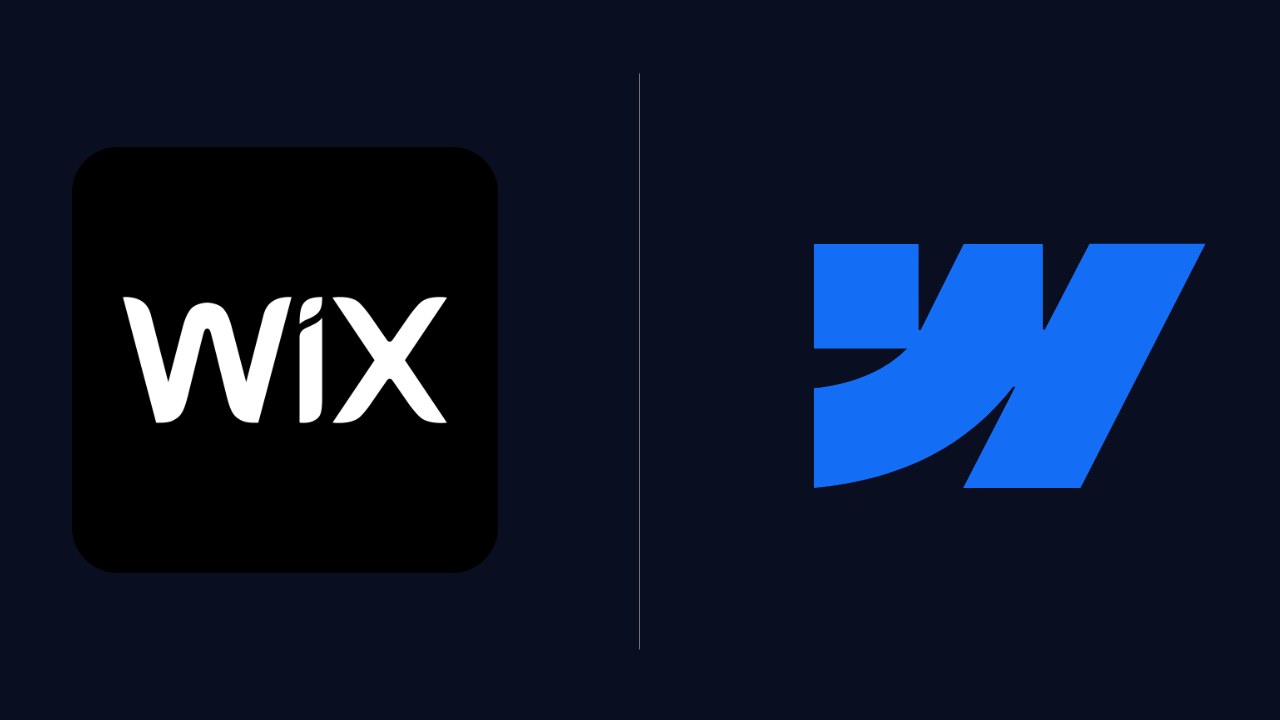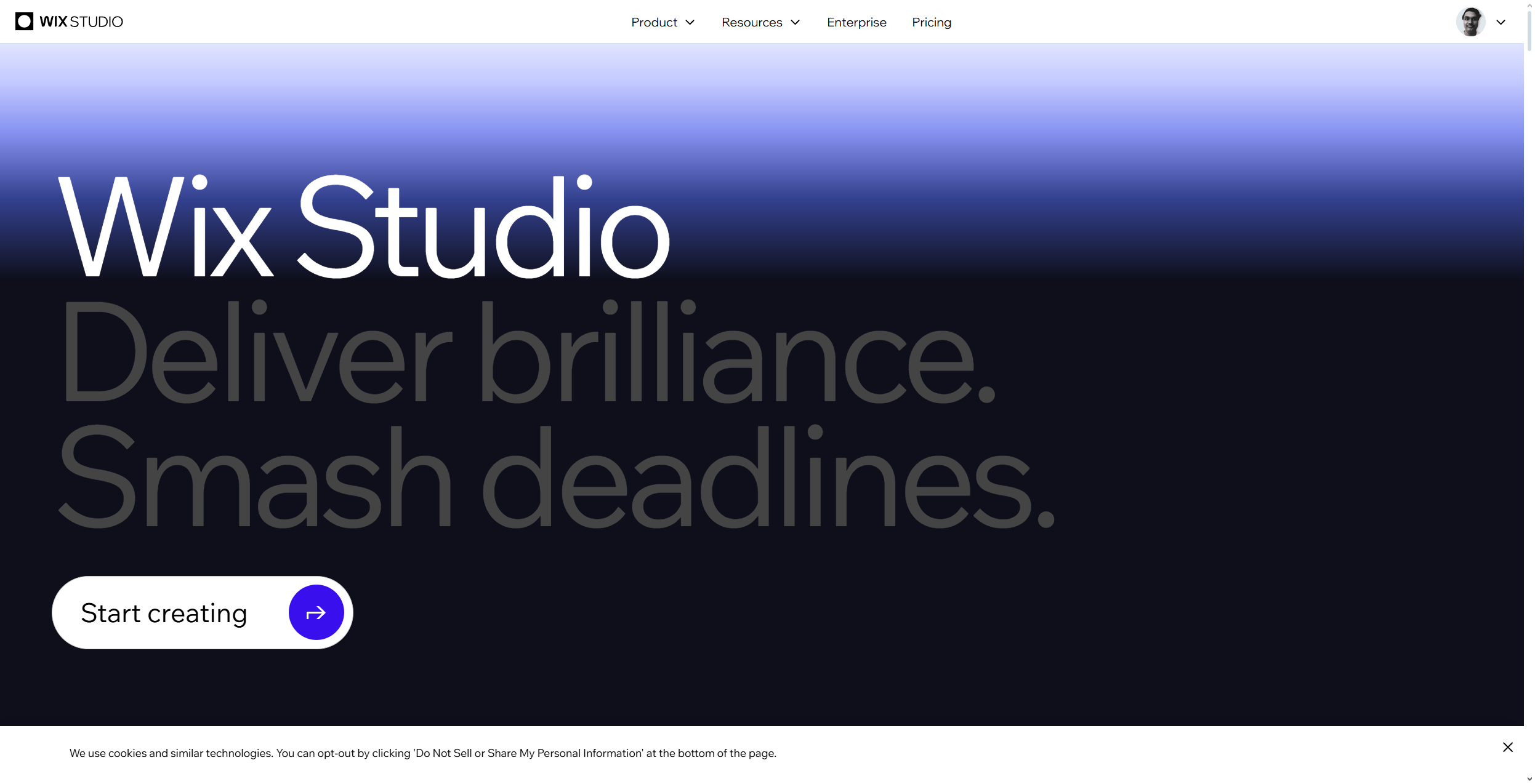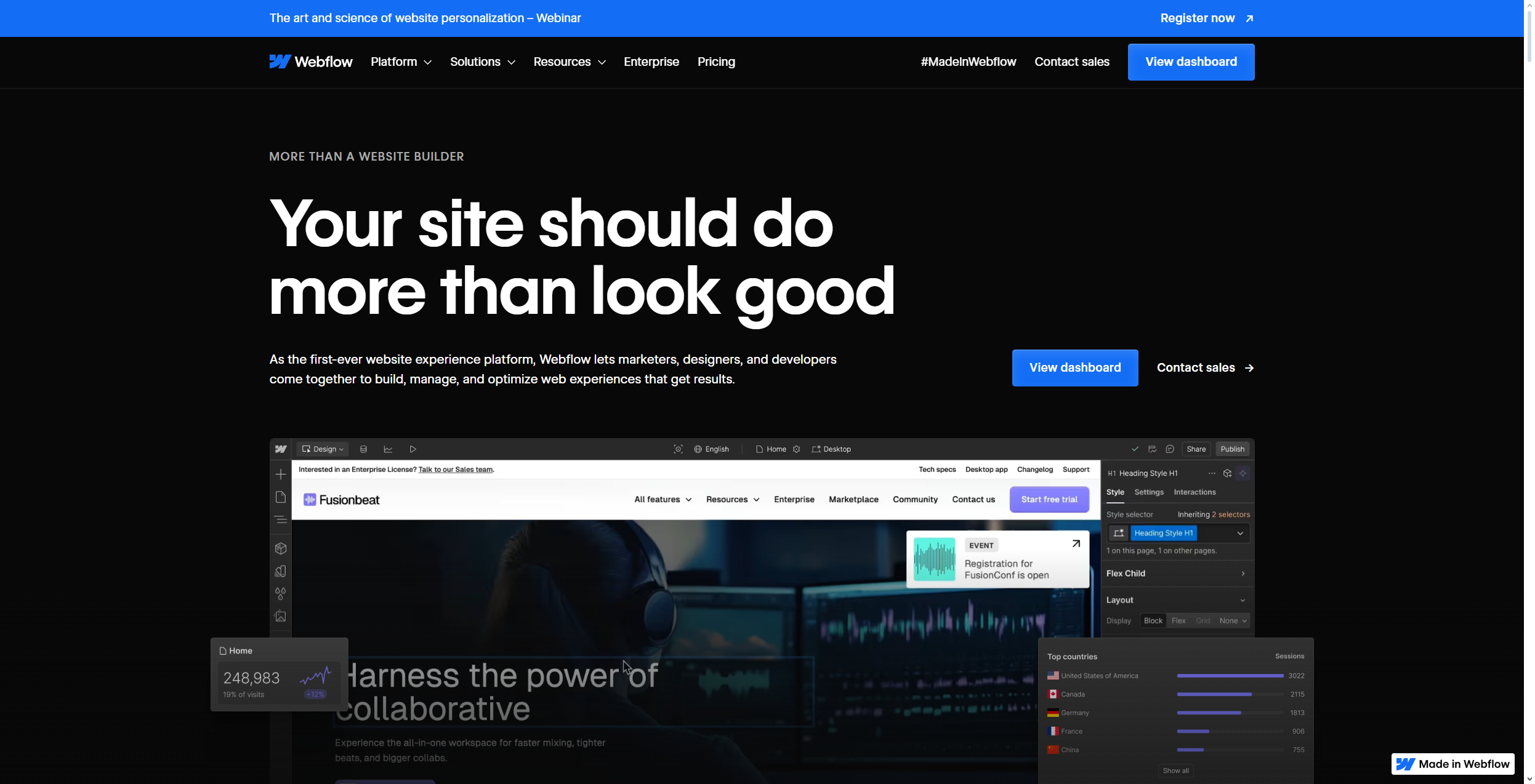Wix Studio vs Webflow: Which is best for your agency?
How to choose the right agency-focused website builder

Wix has been well established as one of the best website builders for some time. In 2023, Wix launched a new platform 'Wix Studio' targeted at creatives, freelancers, and agencies that want more control over the website building process.
Studio has custom breakpoints, smoother animation, and greater support for CSS, leveraging Wix's easy-to-implement capabilities. Studio is one of the best website builders for agencies that work on many projects per customer. The platform balances easy drag-and-drop capabilities with powerful functions, enabling agencies to build quality sites while maintaining an efficient workflow.
Webflow offers a great option for agencies that require full power and premium capabilities. Through powerful visual development capabilities, excellent CMS functions, and clean code generation, Webflow allows agencies to build custom, scalable, and performance-heavy websites without restriction. The platform exhibits premium capabilities by including an extensive list of interaction design capabilities, as well as an adaptive templating system.
Both products target agencies and creatives but cater to distinct areas of the market. Wix Studio targets easy setup and collaboration through work management capabilities. Webflow offers technical expertise and accuracy.
A comprehensive website building platform optimized for agency workflows and team collaboration. Studio combines Wix's intuitive drag-and-drop interface with advanced development tools and AI-powered features. The platform excels in providing integrated business solutions and streamlined project management capabilities.
For
- Intuitive agency workspace management
- Powerful AI-assisted design tools
- Comprehensive 24/7 support available
- Excellent team collaboration features
- All-inclusive pricing structure
Against
- Limited advanced coding options
- Some app compatibility issues
- Restricted template customization depth
- Platform-dependent hosting only
- Feature bloat can overwhelm
A professional-grade visual development platform offering pixel-perfect control and advanced customization capabilities. Webflow empowers agencies with comprehensive CMS features and clean code output, making it ideal for creating sophisticated, scalable websites.
For
- Superior design control
- Clean code output
- Powerful CMS capabilities
- Advanced interaction design tools
- Extensive third-party integrations
Against
- Steep learning curve
- Complex pricing structure
- Limited customer support availability
- Resource-intensive for simple projects
- Page limit restrictions exist
Feature | Wix Studio | Webflow |
|---|---|---|
Design Interface | Drag-and-drop with advanced styling options and responsive AI | Visual development environment with precise control |
Learning Curve | Moderate learning curve, more intuitive than Webflow | Steeper learning curve, requires technical understanding |
CMS Capabilities | Integrated CMS with team collaboration features | Powerful dynamic CMS with custom collections |
Code Control | Custom CSS editing, HTML/JS integration | Full HTML, CSS, and JS control with clean code output |
Animations | Advanced animation tools with preset options | Comprehensive interaction design system with scroll effects |
SEO Features | Built-in SEO tools, server-side rendering | Advanced SEO capabilities with clean code structure |
Scalability | Handles multiple client projects with workspace management | Limited to 100 static pages per project |
Performance | Improved speed compared to classic Wix | Superior performance with optimized code structure |
Team Collaboration | Built-in team management and client tools | Basic collaboration features with CMS roles |
Pricing Structure | Agency-focused pricing with client site management | Project-based pricing tier |

Wix Studio vs Webflow: Features
Wix Studio is an emerging website building tool. It has basic drag-and-drop capabilities and powerful design tools. It has custom breakpoints, smooth animation, and easy handling of CSS, so it is perfect for agencies handling many projects per client. Studio cooperates well with other Wix products, offering useful business functionalities like online shopping, bookings, and blogs, perfect for businesses that prefer everything together.
One of Studio's greatest capabilities is intelligent AI functions that facilitate website building by enabling visualization editing of the sitemap. It also allows team work and management of workspaces, but it has some restrictions with some Wix apps.
Webflow is exceptional due to powerful graphic development capabilities and professional-level capabilities. It offers full control over HTML, CSS, and JavaScript, so it makes it easy to perform detailed adjustments to the design and intricate interactions. It has excellent content management capabilities, including dynamic content, custom collections, and powerful controls over scroll animation, hover, and other crucial capabilities.
Its technical capabilities center on detailed design, with powerful features for SEO, dynamic animation, and clean code. It also fully supports interaction design capabilities, including scrolling, hover, animation, and smooth transition, so it is perfect for developing greatly customized, scalable, and beautiful-looking websites.
Feature-wise, Webflow surpasses Wix Studio if you require powerful technical capabilities and full control over the design, especially for intricate animation and interactions. However, Wix Studio is useful if you work as an agency handling many projects per client, especially if seamless workflow management and included business functionalities are essential.
Wix Studio vs Webflow: Ease of use
Wix Studio is easy to obtain and has an easy-to-use interface, building further upon Wix's normal ease. It has basic building elements and powerful features, so users can add elements wherever. It also has additional powerful elements for users who need them.
Webflow is more difficult to comprehend, and users must understand basic building concepts. It has powerful building elements, but beginners could get confused. However, there are plenty of tutorials and teaching materials found at Webflow University.
There is an apparent difference in just how easy the two products are to use: Wix Studio emphasizes ease while still containing powerful elements, so it is perfect for a range of users. Webflow takes longer to master, but it offers users greater power and authority over work, so it is perfect for pros who want greater flexibility.
Wix Studio vs Webflow: Customer support
Customer support from Wix Studio operates 24 hours, 7 days per week via various means, such as live chat, callback via the phone, and email support. If you communicate only in English, there is three-minute callback support by phone. Live support via chat operates Monday through Friday, from 2 AM to 6 PM EST. Premium users get priority while VIP users get support by phone instantly.
Webflow's support system is extensive, but it has limitations. Support operates Monday through Friday, from 6 AM to 6 PM PST. Regular support via live chat does not exist for all users, but it is available for enterprises. The majority of support comes via email, Webflow University, and Webflow's active community forum.
There's a clear winner when it comes to customer support. Wix Studio offers quick support round-the-clock while Webflow relies mostly on self-help documents and tutorials. Studio should be the natural choice for agencies that require more thorough assistance. But, Webflow is still useful if you're sufficiently advanced to solve issues yourself.
Wix Studio vs Webflow: Security
Wix Studio takes rigorous steps toward maintaining the security of the platform. Wix Studio has PCI DSS Level 1, SOC 2 Type 2, and various certifications by way of ISO. Studio also employs rigorous data encryption via HTTPS, TLS 1.2+, and auto-SSL, while data stored has protection via AES-256 encryption. Plus, Wix Studio has a Security Operations Center (SOC) that operates 24 hours, 7 days per week, monitoring threats, as well as solving possible issues.
Wix Studio has extensive security included in its development. It employs best practices such as threat models, reviews, and penetration tests. It also has rigorous management of threats from third parties, complete anti-fraud payments, and protection.
Webflow emphasizes security by hosting all sites on Amazon Web Services (AWS) secure infrastructure. The platform has SSL encryption, anti-DDoS protection, and backup. The system employs rigorous authentication processes, including two-factor authentication and secure authentication protocols.
Webflow’s system meets SOC 2 standards, which secure data by maintaining organizational controls. Regular tests and updates are conducted, and users are able to add additional security elements such as CAPTCHA and custom security headers.
Both offer excellent security, but Wix Studio has tighter security due to its tighter enterprise-level security and active monitoring. Although Webflow has excellent basic security via AWS, Wix Studio’s additional protection layers and specialized personnel make it particularly attractive to agencies handling sensitive customer data.

Wix Studio vs Webflow: Tools, add-ons, and extras
Wix Studio has significantly developed its AI tools, with many added capabilities. The platform has Responsive AI, which adapts layouts instantly with one click. AI Code Assistant offers code recommendations and explanations directly to the coder. The platform also includes AI capabilities for creating meta tags, generating images, and creating content, making content creation smoother.
Wix Studio offers agency-specific capabilities, including one single workspace to work with sites, teams, and subscriptions, as well as an exclusive app for managing it while away from the computer. The platform includes custom roles and permissions, allows individuals to work together on a canvas, and offers various business capabilities like ecommerce, events, and bookings.
AI capabilities by Webflow are aimed at enhancing optimization and workflow. Webflow's AI Assistant assists in creating and altering content, setting up SEO, and automatically applying alt tags to images. The platform also includes AI-enabled building processes, able to generate fresh elements, parts, and sections from word inputs, and it also makes bulk changes in terms of style.
Webflow enhances capabilities by utilizing various other third-party tools and integrations. Notable add-ins are Relume, used for building out sites, Typeform, used for creating forms, and specialized SEO capabilities like Fluid SEO. The platform also includes Intellimize, enabling personalization capabilities, as well as enhancing the rate of conversion, and also offers translating capabilities, driven by machine learning.
Both platforms have powerful AI capabilities, but both work differently - Wix Studio aims to automate workflow and generate content. Webflow, on the other hand, focuses mainly on optimization and personalization. Wix Studio includes many agency management capabilities included. Webflow's offering is limited in that way, although it does offer separate workspace plans for agencies and freelancers.
Wix Studio vs Webflow: Hardware
Wix Studio employs an infrastructure consisting of multiple clouds, including AWS, Google Cloud, and data centers, with over 200 nodes across the globe via Fastly. The platform receives over 4.5 billion requests per day, has automatic disaster recovery, an uptime level of 99.98%, and has a 24-hour, 7-day operation center.
Webflow hosting relies on Amazon Web Services (AWS) and Cloudflare, achieving global coverage via CDN and support for HTTP/2 and HTTP/3 protocols. The platform automatically scales, enhances images, compresses data, and defends against failures due to DDoS attacks and bots, also via its CDN vendor.
Both hosting plans provide quality hosting, but, Wix Studio's infrastructure consisting of multiple clouds has greater backup capabilities and dependability. Both plans have equal basic functionalities, including coverage across the globe via CDN.
Wix Studio vs Webflow: Pricing
Wix offers one of the best free website builder plans and, perhaps surprisingly, you can access Wix Studio on its free tier. However, as Wix Studio has been built with agencies and creatives in mind this seems counter intuitive as anyone on the free plan will encounter limits such as onsite ads and an inability to connect a custom domain.
For a more professional approach, Wix Studio can also be accessed on premium plans ranging from $19 to $159 per month if you pay annually. The $19 per month option has basic functions and offers you 2GB of data. The $27 per month Standard option unlocks ecommerce features and offers you 50GB of data. The $36 per month Plus option and the $159 per month Elite option are for mature businesses that require more, offering you unlimited data and premium support.
Webflow leans towards a more complicated pricing structure. It offers Site Plans starting from $14 per month, which includes hosting, domains, and CMS capabilities. Its ecommerce plans range from $29 per month up to $212 per month depending on the products and functions you need. Workplace Plans start from $19-49 per month, if you're an agency looking to build multiple websites without hosting them.
Wix Studio offers easy prices with various functions per level, whereas Webflow requires you to choose between Site and Workplace plans depending on your business model. In 2025, Webflow has changed significantly, increasing the price per workspace. Wix Studio still offers easy prices though.
Wix Studio vs Webflow: Final verdict
Wix Studio is an option that is preferable for agencies that want seamless, streamlined workflows. It is less complicated to work with than Webflow. Studio has streamlined pricing and powerful client management features, so it is best suited for agencies who are just starting out. Alternatively, Webflow is more complex and offers greater control over your designs. It remains one of the best options for agencies if you want detailed designs and intricate interactions.
Are you a pro? Subscribe to our newsletter
Sign up to the TechRadar Pro newsletter to get all the top news, opinion, features and guidance your business needs to succeed!

Ritoban Mukherjee is a tech and innovations journalist from West Bengal, India. These days, most of his work revolves around B2B software, such as AI website builders, VoIP platforms, and CRMs, among other things. He has also been published on Tom's Guide, Creative Bloq, IT Pro, Gizmodo, Quartz, and Mental Floss.
You must confirm your public display name before commenting
Please logout and then login again, you will then be prompted to enter your display name.